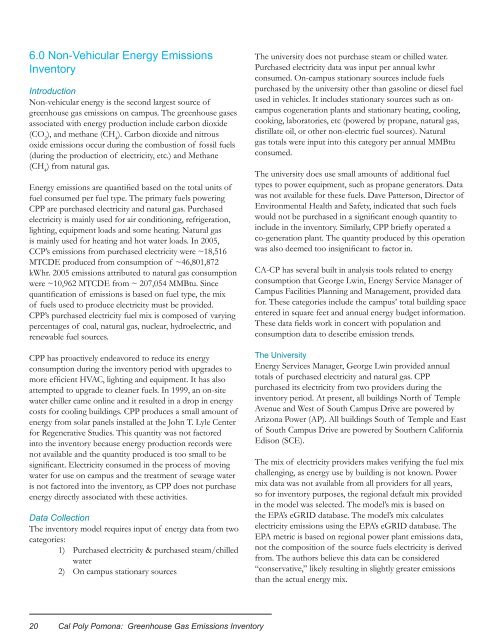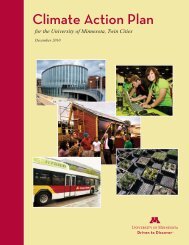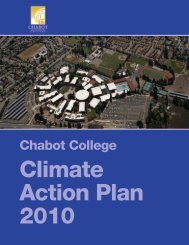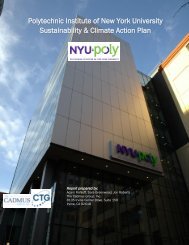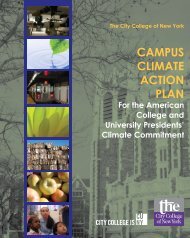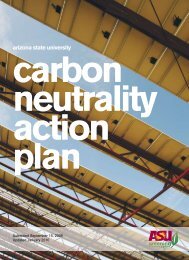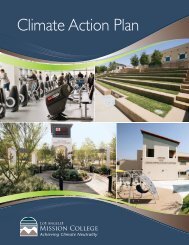Greenhouse Gas Emissions Inventory Report - Cal Poly Pomona
Greenhouse Gas Emissions Inventory Report - Cal Poly Pomona
Greenhouse Gas Emissions Inventory Report - Cal Poly Pomona
You also want an ePaper? Increase the reach of your titles
YUMPU automatically turns print PDFs into web optimized ePapers that Google loves.
6.0 Non-Vehicular Energy <strong>Emissions</strong><br />
<strong>Inventory</strong><br />
Introduction<br />
Non-vehicular energy is the second largest source of<br />
greenhouse gas emissions on campus. The greenhouse gases<br />
associated with energy production include carbon dioxide<br />
(CO 2<br />
), and methane (CH 4<br />
). Carbon dioxide and nitrous<br />
oxide emissions occur during the combustion of fossil fuels<br />
(during the production of electricity, etc.) and Methane<br />
(CH 4<br />
) from natural gas.<br />
Energy emissions are quantified based on the total units of<br />
fuel consumed per fuel type. The primary fuels powering<br />
CPP are purchased electricity and natural gas. Purchased<br />
electricity is mainly used for air conditioning, refrigeration,<br />
lighting, equipment loads and some heating. Natural gas<br />
is mainly used for heating and hot water loads. In 2005,<br />
CCP’s emissions from purchased electricity were ~18,516<br />
MTCDE produced from consumption of ~46,801,872<br />
kWhr. 2005 emissions attributed to natural gas consumption<br />
were ~10,962 MTCDE from ~ 207,054 MMBtu. Since<br />
quantification of emissions is based on fuel type, the mix<br />
of fuels used to produce electricity must be provided.<br />
CPP’s purchased electricity fuel mix is composed of varying<br />
percentages of coal, natural gas, nuclear, hydroelectric, and<br />
renewable fuel sources.<br />
CPP has proactively endeavored to reduce its energy<br />
consumption during the inventory period with upgrades to<br />
more efficient HVAC, lighting and equipment. It has also<br />
attempted to upgrade to cleaner fuels. In 1999, an on-site<br />
water chiller came online and it resulted in a drop in energy<br />
costs for cooling buildings. CPP produces a small amount of<br />
energy from solar panels installed at the John T. Lyle Center<br />
for Regenerative Studies. This quantity was not factored<br />
into the inventory because energy production records were<br />
not available and the quantity produced is too small to be<br />
significant. Electricity consumed in the process of moving<br />
water for use on campus and the treatment of sewage water<br />
is not factored into the inventory, as CPP does not purchase<br />
energy directly associated with these activities.<br />
Data Collection<br />
The inventory model requires input of energy data from two<br />
categories:<br />
1) Purchased electricity & purchased steam/chilled<br />
water<br />
2) On campus stationary sources<br />
The university does not purchase steam or chilled water.<br />
Purchased electricity data was input per annual kwhr<br />
consumed. On-campus stationary sources include fuels<br />
purchased by the university other than gasoline or diesel fuel<br />
used in vehicles. It includes stationary sources such as oncampus<br />
cogeneration plants and stationary heating, cooling,<br />
cooking, laboratories, etc (powered by propane, natural gas,<br />
distillate oil, or other non-electric fuel sources). Natural<br />
gas totals were input into this category per annual MMBtu<br />
consumed.<br />
The university does use small amounts of additional fuel<br />
types to power equipment, such as propane generators. Data<br />
was not available for these fuels. Dave Patterson, Director of<br />
Environmental Health and Safety, indicated that such fuels<br />
would not be purchased in a significant enough quantity to<br />
include in the inventory. Similarly, CPP briefly operated a<br />
co-generation plant. The quantity produced by this operation<br />
was also deemed too insignificant to factor in.<br />
CA-CP has several built in analysis tools related to energy<br />
consumption that George Lwin, Energy Service Manager of<br />
Campus Facilities Planning and Management, provided data<br />
for. These categories include the campus’ total building space<br />
entered in square feet and annual energy budget information.<br />
These data fields work in concert with population and<br />
consumption data to describe emission trends.<br />
The University<br />
Energy Services Manager, George Lwin provided annual<br />
totals of purchased electricity and natural gas. CPP<br />
purchased its electricity from two providers during the<br />
inventory period. At present, all buildings North of Temple<br />
Avenue and West of South Campus Drive are powered by<br />
Arizona Power (AP). All buildings South of Temple and East<br />
of South Campus Drive are powered by Southern <strong>Cal</strong>ifornia<br />
Edison (SCE).<br />
The mix of electricity providers makes verifying the fuel mix<br />
challenging, as energy use by building is not known. Power<br />
mix data was not available from all providers for all years,<br />
so for inventory purposes, the regional default mix provided<br />
in the model was selected. The model’s mix is based on<br />
the EPA’s eGRID database. The model’s mix calculates<br />
electricity emissions using the EPA’s eGRID database. The<br />
EPA metric is based on regional power plant emissions data,<br />
not the composition of the source fuels electricity is derived<br />
from. The authors believe this data can be considered<br />
“conservative,” likely resulting in slightly greater emissions<br />
than the actual energy mix.<br />
20 <strong>Cal</strong> <strong>Poly</strong> <strong>Pomona</strong>: <strong>Greenhouse</strong> <strong>Gas</strong> <strong>Emissions</strong> <strong>Inventory</strong>


